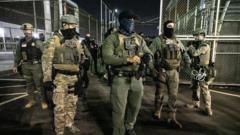As NATO leaders recalibrate military spending, they embrace innovative approaches to meet President Trump’s demands, redefining traditional defense measures to include infrastructure and cybersecurity enhancements.
**NATO Adapts to Trump's Demands: A Shift in Military Spending Strategy**

**NATO Adapts to Trump's Demands: A Shift in Military Spending Strategy**
European nations pivot their defense budgets, expanding what qualifies as security amid shifting U.S. relations.
In an era of heightened tensions stemming from the Russia-Ukraine conflict, NATO continues to reevaluate its defense strategies amid pressures from the United States. President Trump has long insisted that NATO allies increase their military budgets significantly, sparking diverse responses across Europe. Initially dismissing his request for members to allocate 5 percent of their GDP to defense spending, European nations are now finding new pathways to meet these pressures through a redefined approach to military expenditure.
Reports indicate that several NATO countries are considering a revised spending strategy that aims for a 3.5 percent commitment to traditional defense items, such as personnel and weaponry, supplemented by an additional 1.5 percent for nontraditional defense-related spending by the year 2032. This innovative category could encompass various infrastructure projects aimed at bolstering military logistics, including the enhancement of railways and bridges to accommodate military convoys, the fortification of cybersecurity measures, and the development of cutting-edge technologies for defense infrastructure.
The shifting perspective on what constitutes essential military spending emerges amid concerns about the implications of potential reductions in American military support for Europe. NATO Secretary General Mark Rutte emphasized the importance of ensuring that all necessary components for effective defense are in place. He used the metaphor of safely crossing a bridge with a tank to underscore the need for improved infrastructure to facilitate military readiness.
As discussions around defense budgets evolve, NATO’s collective strategy towards military spending highlights a more comprehensive approach, responding to the demands of current geopolitical realities. The alliance continues to adapt in its pursuit of safeguarding member states against emerging threats, reflecting a blend of traditional military investments and modern security imperatives.
Reports indicate that several NATO countries are considering a revised spending strategy that aims for a 3.5 percent commitment to traditional defense items, such as personnel and weaponry, supplemented by an additional 1.5 percent for nontraditional defense-related spending by the year 2032. This innovative category could encompass various infrastructure projects aimed at bolstering military logistics, including the enhancement of railways and bridges to accommodate military convoys, the fortification of cybersecurity measures, and the development of cutting-edge technologies for defense infrastructure.
The shifting perspective on what constitutes essential military spending emerges amid concerns about the implications of potential reductions in American military support for Europe. NATO Secretary General Mark Rutte emphasized the importance of ensuring that all necessary components for effective defense are in place. He used the metaphor of safely crossing a bridge with a tank to underscore the need for improved infrastructure to facilitate military readiness.
As discussions around defense budgets evolve, NATO’s collective strategy towards military spending highlights a more comprehensive approach, responding to the demands of current geopolitical realities. The alliance continues to adapt in its pursuit of safeguarding member states against emerging threats, reflecting a blend of traditional military investments and modern security imperatives.





















